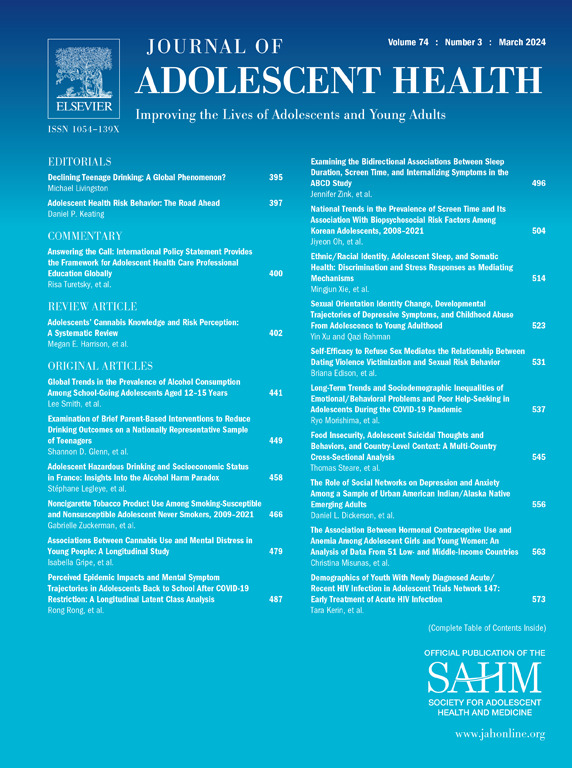2008-2019年墨西哥全国青少年怀孕预防方案背景下的青少年生育趋势
IF 4.5
2区 医学
Q1 PEDIATRICS
引用次数: 0
摘要
目的:我们描述了墨西哥在2015年实施国家预防青少年怀孕战略(西班牙语为ENAPEA)之前和之后的青少年(10-14岁)和青少年(15-19岁)的生育情况,该战略的目标是将青少年的总体生育率减半,并消除15岁以下青少年的生育现象。方法:我们使用2008-2019年的行政出生证明数据,并按年龄组计算出生率和出生率。然后,我们计算了国家和州一级ENAPEA之前(2008-2014)和之后(2015-2019)的出生比例和出生率的变化。我们使用线性回归模型来评估出生率变化与ENAPEA实施之间的关系。我们还计算了第一胎与第二胎或更高胎的出生比例。结果:总体而言,墨西哥约20%的新生儿是未成年人和青少年,随着时间的推移变化不大。在enapea前(2008-2014年)期间,VYA和青少年出生率增加或保持稳定,在enapea后(2015-2019年)期间下降。这两个年龄组的出生率都有小幅但显著的下降,这与开始实施ENAPEA有关。第二级或更高一级的出生比例显著下降。讨论:我们的研究结果提供了一些关键的见解,以帮助理解ENAPEA背景下青少年生育率的下降,特别关注VYA母亲,并对第一胎和第二胎/第三胎生育有新的见解。本文章由计算机程序翻译,如有差异,请以英文原文为准。
Trends in Adolescent Births in Mexico in the Context of a National Adolescent Pregnancy Prevention Program, 2008–2019
Purpose
We describe very young adolescent (VYA, 10–14) and adolescent (15–19) births in Mexico before and after the implementation of the National Strategy for the Prevention of Adolescent Pregnancy (ENAPEA in Spanish) in 2015, which has as the goal to halve adolescents' overall fertility and eradicate births in those under 15.
Methods
We used administrative birth certificate data, 2008–2019 and calculated the proportions of births and birthrates by age group over time. We then calculated the change in proportion of births and in birthrates before (2008–2014) and after (2015–2019) ENAPEA at national and state level. We used linear regression models to assess association between changes in birthrates and the implementation of ENAPEA. We also calculated the proportion of births that were first versus second- or higher-order births.
Results
Overall, about 20% of births in Mexico are to VYA and adolescents, with little change over time. VYA and adolescent births increased or were stable in the pre-ENAPEA (2008–2014) period and declined in the post-ENAPEA period (2015–2019). Small but significant reductions in birthrates for both age groups are associated with the beginning of the implementation of ENAPEA. There were important reductions in the proportion of births that are second order or higher.
Discussion
Our results provide some key insights to help understand declines in adolescent births in the context of ENAPEA, with a particular focus on VYA mothers and a novel insight on first and second-/third-order births.
求助全文
通过发布文献求助,成功后即可免费获取论文全文。
去求助
来源期刊

Journal of Adolescent Health
医学-公共卫生、环境卫生与职业卫生
CiteScore
10.40
自引率
3.90%
发文量
526
审稿时长
46 days
期刊介绍:
The Journal of Adolescent Health is a scientific publication dedicated to enhancing the health and well-being of adolescents and young adults. Our Journal covers a broad range of research topics, spanning from the basic biological and behavioral sciences to public health and policy. We welcome a variety of contributions, including original research papers, concise reports, literature reviews, clinical case reports, opinion pieces, and letters to the editor. We encourage professionals from diverse disciplines such as Anthropology, Education, Ethics, Global Health, Health Services Research, Law, Medicine, Mental and Behavioral Health, Nursing, Nutrition, Psychology, Public Health and Policy, Social Work, Sociology, and Youth Development to share their expertise and contribute to our mission of promoting adolescent health. Moreover, we value the voices of young individuals, family and community members, and healthcare professionals, and encourage them to submit poetry, personal narratives, images, and other creative works that provide unique insights into the experiences of adolescents and young adults. By combining scientific peer-reviewed research with creative expressions, our Journal aims to create a comprehensive understanding of the challenges and opportunities in adolescent and young adult health.
 求助内容:
求助内容: 应助结果提醒方式:
应助结果提醒方式:


